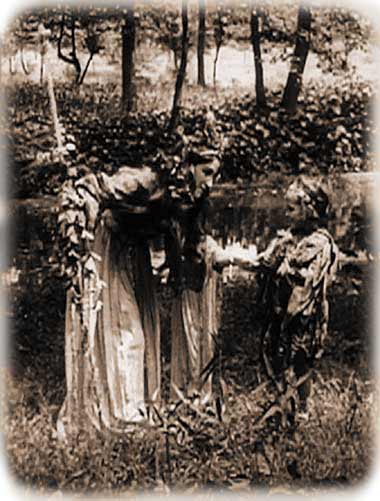
Vitagraph 8 continued from page 7
Titania Meets Puck in a Glade. Puck is played by Gladys Hulette, a seasoned
pro of the stage at 13. (Courtesy of Milestone Film &
Video

www.milestonefilms.com.)
So, the lighter side of Shakespeare was
the key to success! The Dream was followed by Twelfth
Night in about six weeks time and it too received an enthusiastic
reception: "The staging is according to the best traditions of
Shakespeare's time and the acting is in harmony with the modern
understanding of the piece." Yet, despite the excitement created by these
films, there wasn't to be another Shakespeare film until 1912—if the
Indian Romeo and Juliet and Cardinal Wolsey, with
borrowings from Henry VIII, can be considered such. Later in the
year, Vitagraph produced a three-reeler of As You Like It that
faltered, to no small degree because,
in the European fashion, it went outside the stock company for Rosalind,
nabbing one of the grandest of dames on the American stage, Rose Coghlan,
who was 61 years old. Thus, though the production was given credit for
producing a picture that on the whole had met the high standard Vitagraph
had set, "Without the youth demanded of the role, Rosalind is not Rosalind
to those who sit in the front and no imagination, nor kindly feeling
toward an actress ... can make it so." Nor, without a heroine who had
"the girlish spirit of frolic," could this picture succeed, and it did
not.
There was talk of a
Hamlet in 1914, with a cast list issued and word that a director
was "busily engaged with rehearsals of what is expected to be the most
pretentious film story of a classic ever filmed." But it never appeared
and two years later Vitagraph came as close to Hamlet, or
Shakespeare, as it ever was in its later years: Freddy Versus
Hamlet—in which a young swain wins back the love of his lady, who had
fallen for an actor playing the role. For lovers of Shakespeare who may
have looked for some vestige of the magic of earlier days, this
Freddy must truly have been a nightmare from Elm
Street.
Sadly, due to neglect, misfortune and decay, the greater number of the
Big V's Shakespearean silents survive only in stills, strips of
paper negatives or snippets of the original. However, two of the very best—A Midsummer Night's Dream and Twelfth Night—were preserved. They, along
with three British and two Italian one-reelers, have been restored by the
British Film Institute and are now available on the videotape Silent Shakespeare: Such Stuff as Dreams Are Made
on...
In addition to being a precious part
of film history, the Vitagraph Shakespeares also capture precious parts of
Brooklyn as it was a hundred years ago. The enchanted forest of the Dream
is a chestnut woods in Greenfield that is long gone, while the scene of
Bottom recounting his woodland experiences to his fellows was shot at the
Ocean Avenue entrance to Prospect Park.
Vitagraph continued to produce films of high quality after the Shakespeare
one-reelers, but most were from original stories. One of its later
literary ventures, Black Beauty (1921), had a great impact on the
future of the movies. It was the first film six-year-old Ingmar Bergman
had seen: "I still recall a sequence with a fire. I remember that vividly.
And I remember too how it excited me, and how afterwards we bought the
book Black Beauty and how I
learned the chapter on the fire by heart." It would also introduce many
future stars to the screen—as well as one man who gained prominence in
another line of work. This was a "technical adviser," Leon Trotsky by
name, who also worked as an extra in films. His image survives in a still
from My Official Wife, which also included an
appearance by a 17-year-old set decorator, Rudolph Valentino.
©2000 The Composing Stack Inc. All rights
reserved.
urbanography is a service mark of The Composing Stack
Inc.
Updated July 21, 2000.
Type correction August 4,
2000